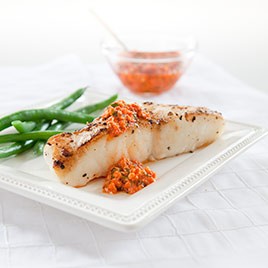Skillet-Roasted Fish Fillets

Pan-roasted fish seems like a simple dish, but in reality it is usually only well executed by practiced chefs. At home, the dish often results in dry, overbaked fillets. We set out to develop a foolproof recipe for producing succulent, well-browned fillets.
From an initial round of testing, we knew we needed thick fillets; skinnier pieces end up overcooked by the time they’ve achieved a serious sear. We then turned to a common restaurant method to cook the fish: Sear the fillet in a hot pan, flip, then transfer it to a hot oven to finish cooking. The technique was sound, but to brown the fish quickly before the hot pan had a chance to dry out the fish’s exterior we turned to a sprinkling of sugar. The idea is that sugar commingles with exuded juices from the fish, accelerating browning and giving the fish a rich color and deep flavor that’s anything but sweet. We dusted a few fillets with a touch of granulated sugar and placed them in a hot skillet. A well-browned crust formed almost immediately, leaving no time for the interior to dry out. And after a short stay in the oven to finish cooking through, the fish emerged well-browned, tender and moist, and best of all, not one taster detected any out-of-place sweetness.
Fish begins to contract and dry out when its internal temperature reaches 120 to 135 degrees, far below the 300 degrees it takes for a good sear and for hundreds of new flavor compounds to be created in the process known as the Maillard reaction. Our challenge, then, was to get the fish to achieve this flavorful browning at a much lower temperature.
Here’s how we did it: When sugar (sucrose) is added to the wet surface of fish and is exposed to the heat of the pan, it quickly breaks down to glucose and fructose. Fructose begins to rapidly caramelize at around 200 degrees—a temperature the exterior of the fish easily reaches within a minute or so of hitting the hot pan. Thus, a little bit of sugar sprinkled on a fillet will lead to faster browning than an unsugared one, helping a good crust to form before the interior dries out.
4 skinless white fish fillets, 1 to 1 1/2 inches thick (about 6 to 8 ounces each) (see note)
Kosher salt and ground black pepper
1/2 teaspoon sugar
1 tablespoon vegetable oil
Lemon wedges
- Adjust oven rack to middle position and heat oven to 425 degrees.
- Dry fish thoroughly with paper towels and season with salt and pepper.
- Sprinkle very light dusting of sugar (about 1/8 teaspoon) evenly over 1 side of each fillet.
- Heat oil in large ovensafe nonstick skillet over high heat until smoking.
- Place fillets in skillet, sugared sides down, and press down lightly to ensure even contact with pan.
- Cook until browned, 1 to 1½ minutes.
- Using 2 spatulas, flip fillets and transfer skillet to oven.
- Roast fillets until centers are just opaque and register 135 degrees on instant-read thermometer, 7 to 10 minutes.
- Immediately transfer to serving plates and serve with lemon wedges.
Note: Thick white fish fillets with a meaty texture, like halibut, cod, sea bass, or red snapper, work best in this recipe. If your fillets happen to come with skin, follow the instructions below to remove it. Because most fish fillets differ in thickness, some pieces may finish cooking before others—be sure to immediately remove any fillet that reaches 135 degrees. Serve the fish with lemon wedges or a relish.
None Available.